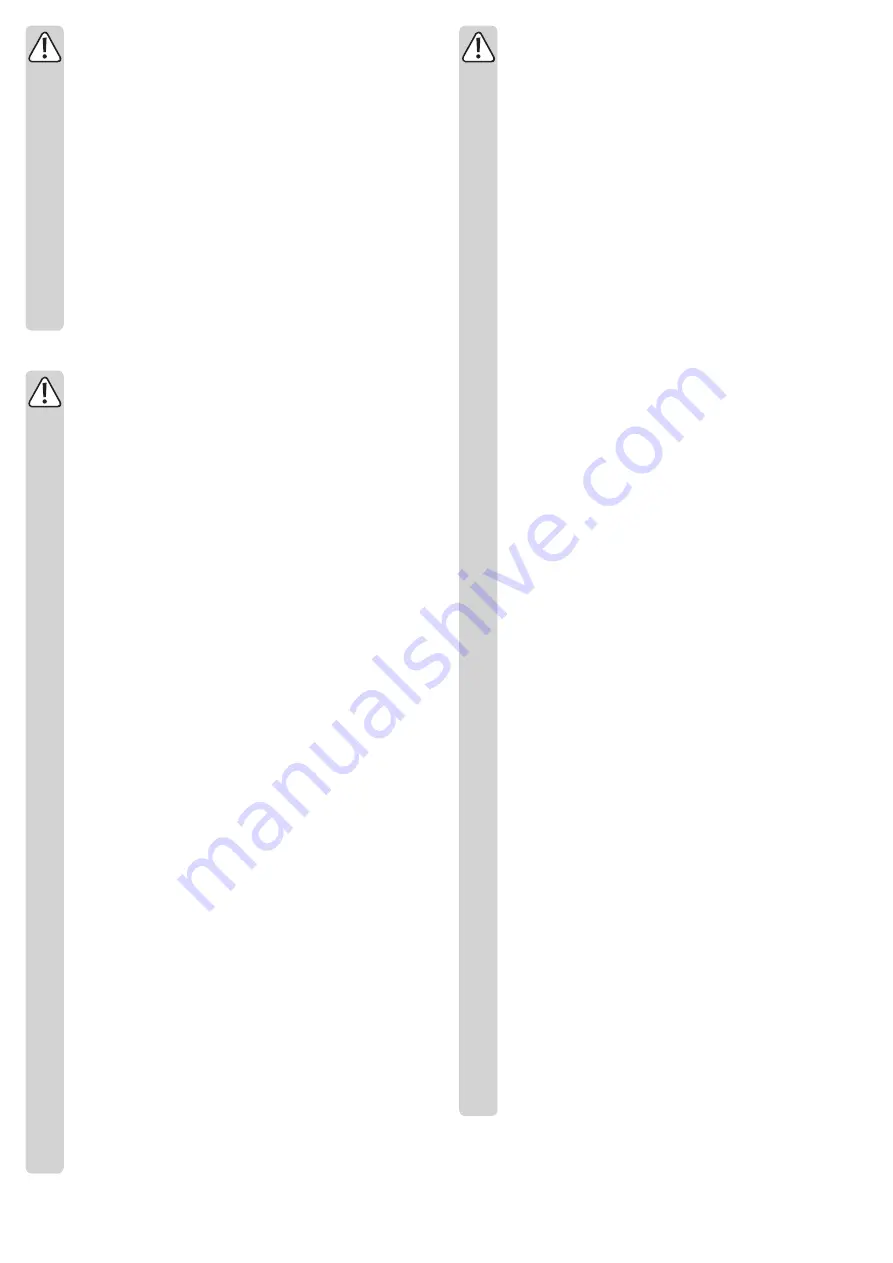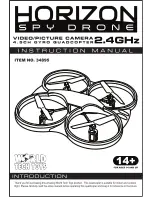
•
Always leave the remote control turned on when the model is in use. After landing,
always flick the on/off switch on the quadrocopter to the “off” position (“OFF”). Only
then can the remote control transmitter be turned off.
•
In case of a fault or a malfunction, establish the cause of the problem before using
the model again.
•
Do not expose the model or the remote control to direct sunlight or excessive heat
for prolonged periods.
•
In the event of a heavy crash (e.g. from a high altitude), the electronic gyro sen-
sors can be damaged. Therefore, the model must be tested for full functionality
before flying again!
•
In the event of a crash, you must immediately switch off the rotor motors. Rota-
ting rotors may be damaged if they come into contact with obstructions or in the
event of impacts. Before flying again, they must be checked for possible cracks
or breakages!
•
To avoid damaging the model in a crash caused by undervoltage or by a deep
discharge of the battery, we recommend observing the undervoltage light signals
at all times when flying the model.
•
Pay attention to the maximum ranges according to the technical data in these
operating instructions. If the model flies out of range, it will fly unchecked until it
crashes! This will void the warranty/guarantee.
Information relevant to (rechargeable) batteries
Batteries present numerous safety hazards. Compared with conventional
NiMH rechargeable batteries, LiPo/Li-ion rechargeable batteries have a
high energy content. For this reason, it is essential to comply with safety
regulations to prevent the risk of a fire or explosion.
Always observe the following safety information when handling batteries.
a) General information
•
Keep batteries out of the reach of children. Batteries must be kept out of the reach
of children.
•
Do not leave batteries lying around, as they present a choking hazard for children
and pets. Seek immediate medical advice if a battery is swallowed.
•
Batteries/rechargeable batteries must never be short-circuited, taken apart or th-
rown into fire. Danger of explosion!
•
When handling leaking or damaged batteries, always use suitable protective
gloves to avoid burning your skin.
•
Liquids leaking from batteries are very chemically aggressive. Objects or surfaces
that come into contact with these liquids could become seriously damaged. Al-
ways store batteries in a suitable location that is not prone to damage.
•
Do not attempt to recharge disposable, non-rechargeable batteries. This may
cause a fire or explosion! Non-rechargeable batteries are only designed to be
used once and must be disposed of properly when they are empty. Only rechar-
ge compatible rechargeable batteries and ensure that you use a suitable battery
charger.
•
If you do not plan to use the vehicle for an extended period, remove the batteries
from the remote control to prevent them from leaking and causing damage. Store
the product in a dry, clean and cool place that is out of the reach of children. The
same applies to batteries/rechargeable batteries.
Install a smoke detector in the room. Batteries present a fire hazard and may
generate toxic fumes. This applies in particular to batteries for model toys, which
are subjected to high charging/discharge currents and vibrations.
•
Always exchange the entire set of batteries in the remote control. Do not mix full
batteries with half-full ones. Always use batteries of the same type and from the
same manufacturer. Never mix disposable batteries with rechargeable batteries.
•
Please observe correct polarity (plus/+ and minus/-) when inserting the batteries/
rechargeable batteries into the transmitter.
• Do not expose the charger and the quadrocopter/rechargeable flight battery to
high/low temperatures or direct sunlight.
•
Batteries must not become damp or wet. The same applies to the charger and the
quadrocopter/rechargeable flight battery. The charger must only be used in dry,
enclosed indoor areas.
Lithium rechargeable batteries (e.g. LiPo/Li-ion batteries) are especially sensitive
to moisture because of the chemicals they contain.
• Place the charger and the quadrocopter/rechargeable flight battery onto a non-
flammable, heat-resistant surface (e.g. stone tiles). Keep the charger and battery
away from flammable objects. Leave enough distance between the charger and
the quadrocopter/rechargeable flight battery.
•
Do not charge batteries when they are still hot (e.g. due to a high discharge current
in the model). Allow the rechargeable flight battery to cool down to room tempe
-
rature before charging it.
• As the charger as well as the rechargeable flight battery heat up during the char
-
ging procedure, it is necessary to ensure sufficient ventilation. Never cover the
charger and the rechargeable flight battery!
•
Never leave batteries unattended when they are charging. Inspect the charger at
regular intervals to ensure that the battery is not overheating or expanding. This
indicates an imminent risk of a fire or explosion. If the rechargeable flight battery
overheats or starts to expand, disconnect it from the charger immediately and
take it to a location where it will not cause any additional damage if it explodes or
catches fire (e.g. outdoors).
• Disconnect the rechargeable flight battery from the charger when the battery is
fully charged.
•
Never damage the casing of a rechargeable battery. Never charge damaged, lea-
king or misshapen batteries. This may cause a fire or explosion! Discontinue use
immediately and dispose of the battery in an environmentally friendly manner.
•
Rechargeable batteries should be charged regularly (approx. once every 2–3
months) to prevent them from overdischarging. This may result in permanent da-
mage and render the batteries useless.
LiPo/Li-ion batteries usually retain their charge for several months. However, if
the batteries overdischarge, this will result in permanent damage and render them
useless.
b) Additional information about lithium rechargeable batteries
Modern lithium rechargeable batteries have a significantly higher capacity
than NiMH and NiCd batteries and are more lightweight. This makes LiPo
(lithium polymer) or Li-ion batteries particularly suitable for use in the model
making industry.
However, lithium batteries require particular care to ensure safe charging/
discharging, operation and handling.
The following section provides an overview of the potential hazards
associated with lithium batteries and explains how these hazards can be
avoided to ensure a long lifespan.
• The casing of many lithium batteries is made of a thick film, which is very sensitive.
Do not dismantle, drop or insert any objects into lithium batteries. Do not apply
mechanical loads or pull on the battery’s connection cables. This may cause a
fire or explosion!
• The rechargeable flight battery can either be charged separately or inside the
quadrocopter. Since the rechargeable flight battery is screwed into the quadro
-
copter, we recommend that you charge the rechargeable flight battery inside the
quadrocopter. This way it will not need to be unnecessarily dismantled.
•
Ensure that a lithium rechargeable battery does not overheat during use, rechar-
ging, discharging, transport or storage. Do not place the rechargeable flight batte
-
ry (or the quadrocopter with the rechargeable flight battery inside) near heat sour
-
ces and keep it away from direct sunlight. This may cause the battery to overheat,
which can cause a fire or explosion! The temperature of the rechargeable battery
must never 60 °C.
•
If the rechargeable battery is damaged or the outer casing is swollen (e.g. due to
a crash causing damage to the quadrocopter), do not recharge it. This may cause
a fire or explosion!
Never store a damaged rechargeable flight battery in an apartment or in a house/
garage. Damaged or swollen lithium batteries may catch fire.
•
Always use a compatible charger to charge lithium batteries and ensure that the
charging specifications are correct. Do not use NiCd, NiMH or lead-acid battery
chargers, as these may cause a fire or explosion! Always select the correct char
-
ging specifications for your rechargeable battery.
•
If you charge a rechargeable lithium battery with more than one cell, be sure to
use a so-called balancer (the rechargeable battery supplied with the quadcopter
has only one cell).
•
The charge rate for LiPo/Li-ion batteries must not exceed 1 C (or the value stated
in the battery instructions). This means that the charging current must not exceed
the battery capacity (e.g. battery capacity = 1000 mAh, max. charging current =
1000 mA = 1 A).
•
The discharge current must not exceed the value stated on the battery.
For example, if “20C” is printed on the LiPo/Li-ion battery, the maximum discharge
current is 20 times the battery’s capacity (e.g. battery capacity = 1000 mAh, max.
discharge current = 20C = 20 x 1000 mA = 20 A).
Exceeding the maximum current may cause the battery to overheat or become
misshapen, which can lead to a fire or explosion!
The printed value (e.g. 20C) indicates the maximum current that the battery can
deliver for a short period. The continuous current should not be higher than one
half of the stated value.
•
Make sure that a lithium rechargeable battery does not become deeply dischar-
ged. This may destroy the battery or cause permanent damage.
If your model does not have overdischarge protection or a low battery indicator,
stop using it before the battery becomes empty.






















